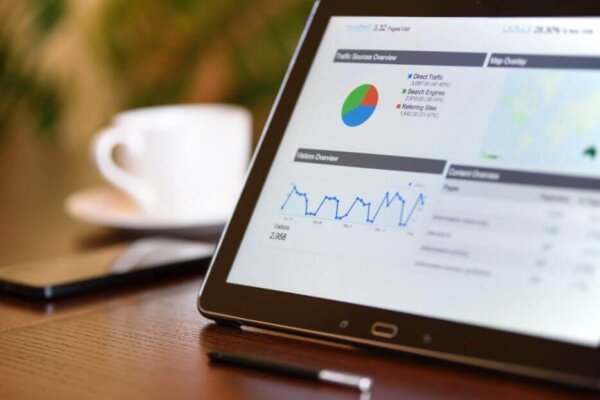
Bounce Rate 101: What It Is, How to Measure It & How to Reduce It
Bounce rate is one of the most monitored metrics in online marketing. It can provide great insights if you know how to interpret it. Here's how to get started.
It’s always a little awkward to walk into a new restaurant, take a look around, check out the menu—then decide you’re not interested and walk out. There might be nothing wrong with the ambiance or the food, but for whatever reason, you don’t want to stay.
The same thing happens all the time to web users. Bounce rate — or the percentage of people who leave the page without interacting with it or clicking through to another page — is one of the most monitored metrics in online marketing.
An Example of Bounce Rate
Let’s say two people visit your homepage. The first person clicks on your “About” page, then leaves. The second person opens your homepage, then clicks the back button on his internet browser. Your homepage’s bounce rate would be 50%.
A page’s bounce rate is only based on sessions that begin with that page. In the above example, the visitor looked at the “About” page before leaving. But because the “About” page was the second she visited, not the first, her exit doesn’t count in its bounce rate.
Causes of a High Bounce Rate
High bounce rates can rarely be isolated to a single factor. Typically, there are two or more things working in conjunction to make people leave your page.
Website speed can have a huge effect. Research shows 40% of people expect a page to load in three seconds or less; if it takes any longer, they won’t stick around.
Unappealing design will also send visitors away from your site in droves. Jarring color schemes, cluttered layouts, hard-to-read text, garish ads, and aggressive pop-ups are all common offenders.
If visitors can’t figure out what to do next, they’ll also bounce. Make sure your site is easy to navigate. Are your labels specific and descriptive? Is your navigation menu easy to find on every page? Have you limited your navigation options to the most important ones?
Optimizing for the wrong keyword can cause high bounce rates as well. Maybe your page is ranking for “virtual secure webinar platform.” However, your product is meant for holding internal meetings, not running webinars. People who found your site via this keyword will quickly realize you don’t have what they’re looking for and leave.
How to Reduce Your Bounce Rate
Improve Your Page Speed
A slow-loading page impacts your site in two ways. First, it makes people bounce, which lowers your conversion rate and hurts your search engine rankings. Second, Google factors in page load speed into its ranking algorithm. That means your page will drop even lower in the results than before.
With consequences like these, improving your load speed is crucial. Share on XWith consequences like these, improving your load speed is crucial. Instead of PNG images, use JPEG files. The quality of JPEG images is fine, but they’re compressed so they’ll load more quickly. You should also keep animations, slideshows, and other effects to a minimum. Not only do these elements often overwhelm users (which can impact your bounce rate in and of itself), but they slow down your page. If you want to incorporate these, spread them out over multiple pages to minimize the impact. The same goes for videos. If you have two-plus YouTube or Vimeo videos on a single page, load time will suffer.
Improve Your Design
Fixing your design can also make a big difference in improving your bounce rate. Visitors quickly leave if the site looks out-of-date or amateurish, so make sure your interface looks modern and professionally designed. If you’re not sure whether your design is the culprit for your bounce rate, conduct user tests to discover what people think when they see your site.
In addition, make sure you’re not burying important content beneath the fold. If users can’t see some of the most important details on your page without scrolling, they might assume it’s not there and leave. Don’t make users search for the high-priority information: put it in clear view at the top.
Don’t make users search for the high-priority information: put it in clear view at the top Share on XAdapt for Mobile
If your design isn’t responsive, you’re definitely sabotaging yourself. Mobile has officially topped other devices as the primary traffic-driver, which means you should assume more people are visiting your site on their phones than computers or tablets. (To get specific percentages, check your site analytics.) Visitors aren’t going to waste time or energy pinching and zooming.
Focus on the Right Target
One of the simplest ways to cut down on your bounce rate? Make sure you’re attracting the right visitors in the first place. Use your site’s analytics to see which search terms are bringing people to your page and compare them to your page’s content. If you discover a misalignment, edit your page’s header, title, meta description, and image alt text so they accurately describe what’s on the page. Now, there’s a much greater chance the people who arrive on your site via search will find what they were looking for — meaning they’ll stick around.
Make sure you’re attracting the right visitors in the first place. Share on XDitch the Pop-Ups
Finally, you should reconsider instant pop-ups. These modals are fairly abrasive, especially to someone who’s just landed on your site. They might decide to click their back button rather than exit the window and continue whatever they’re doing before. In fact, if your pop-up arrives instantly, they probably didn’t have the chance to do anything.
Why Bounce Rate Can Be a Misleading Metric
Many marketers automatically assume that lower bounce rates are better — but in some cases, a high bounce rate means you’re doing something right. It comes down to the specific page and what you’re hoping to accomplish.
In some cases, a high bounce rate means you’re doing something right. Share on XTake the “Contact Us” page for an enterprise software site. The business doesn’t want customers who need help or potential customers who want to contact sales to spend a long time on this page. The best-case scenario? Someone will arrive at the contact page via search engine, find the company’s phone number or email address, and leave the site. If the “Contact Us” page has a low bounce rate, that means visitors are having trouble finding the information they need.
In general, pages dedicated to helping people quickly resolve a problem or learn a piece of information should have higher bounce rates.
The same holds true for conversion-focused pages. As long as your conversion rate is high, it’s okay if a high percentage of visitors are leaving the page without taking action. In fact, that’s usually a good thing, as it means you’re disqualifying the people who aren’t interested in your offer.
Individual blog posts can also have misleading bounce rates. Your reader might love an article, but unless she clicks on another article or goes to a different section of your site, her session will be counted in that post’s bounce rate. That means bounce rate alone isn’t always an accurate representation of site engagement or user satisfaction.
The takeaway? Rather than getting anxious every time you see lots of visitors bouncing, identify your strategy and objectives for that specific page. Then ask yourself whether a high bounce rate means your strategy is working or failing.
Bounce Rate Benchmarks
The most effective way to measure your bounce rate’s quality is to track it over time. If you’re trying to decrease your homepage’s bounce rate, and it goes from 40% to 35%, then you know your efforts are working.
The most effective way to measure your bounce rate’s quality is to track it over time. Share on XHowever, getting a sense for your bounce rate relative to the average can be useful too. Studies suggest blogs have by far the highest bounce rates: from 70 to 98%. Landing pages typically have 70 to 90% bounce rates — which makes sense, considering most landing pages are focused on conversion. Content websites, such as publications or forums, have a 40 to 60% bounce rate. Retail sites and service states have a 20 to 40% bounce rate and 10 to 30% bounce rate, respectively.
It’s worth noting that these averages change depending on the specific vertical, audience, and year. Rather than using them as strict guidelines for what your bounce rate should be, use them to figure out whether your bounce rates are out of the ordinary.
Engage Your Web Users
Fundamentally, your bounce rate is a metric that suggests the engagement level of your web users. It’s a helpful litmus test of how well your online experience resonates with your target user. If you really want to reduce your bounce rate, focus on building an interactive, high quality, user experience that is tailored to your target users.
As you’ll see, it not only improves bounce rate, but many other site metrics as well.
